
TARGET 150415
Choquequirao,
Lost City in the Clouds
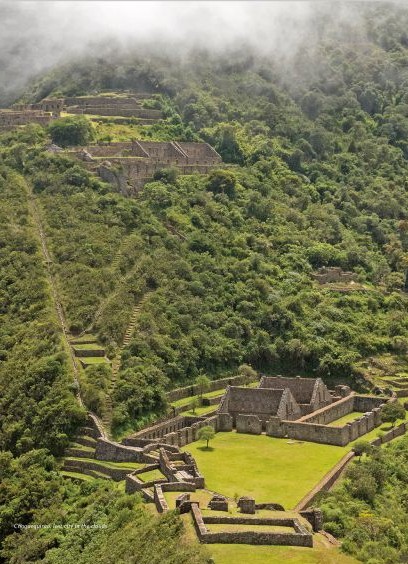
The first rays of morning sunlight illuminate
the great stone altar, streaming through
a square opening over my head. "Inti camac
sumac," chants the priest. Soaked in sweat,
I fight the bindings holding me to the
stone as the grinning, looming, scarlet-cloaked
figure slowly brings down a gleaming,
bloodstained bronze knife toward my heaving chest.
"Jefe, buenos dias - cafe?"
Startled suddenly awake, I thankfully greet a
smiling Pancho, our camp cook, handing a cup
of wake-up coffee through the tent door. Whew -
I make a silent oath to myself to avoid the
second round of piscos that we had passed around
the campfire last night.
We are on our way back to the mysterious and
magnificent mountain Inca city in the remote
cloud-forested Andes of Peru that has been the
focus of my research and explorations for many
years and numerous expeditions.
I am traveling with an interesting group of
ethno-botanists. Our objective is to identify
plants and trees that may have been introduced
by the Inca residents and may still live on in
the tangled vegetation surrounding the recently
cleared stone walls and buildings.
There is always something more to learn at the
Inca's second Machu Picchu.
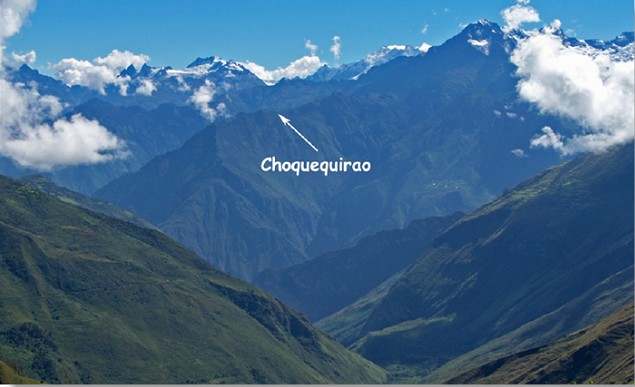
The Inca royal estate and ceremonial complex,
Choquequirao is perched majestically at
9,800 feet of elevation on the cloud-forested
ridge of a glaciated 17,700 foot peak.
The traditionally sacred Apurimac River,
reportedly the longest headwater source of the
Amazon, roars through a deep canyon some
5000 feet below. The site lies 61 miles west
of Cusco in the rugged, remote Vilcabamba
range of the Peruvian Andes, far distant from
roads, trains and the tourist hordes that mob
Choquequirao's famous sister estate, Machu Picchu.
Choquequirao remains one of the great, rewarding
travel destinations of the Americas that still
retain some of the excitement and discovery
experience of the past.
It is a truly 'lost city,' abandoned sometime
around 1572 when the holdout last Inca ruler,
Tupac Amaru was captured in the distant
jungles, dragged back to Cusco and executed
by Spanish colonial authorities. The ancient
houses, temples, canals and walls were soon
reclaimed by the silent, green, primeval
forest only to be rediscovered and revealed
in recent times. Located on the far, unpopulated
and geographically hostile side of the immense
Apurimac Canyon, the region remained disconnected
from the farms, villages and roads of developing
Peru.
It is little known that Yale professor Hiram
Bingham, the now famous scientific discoverer
of Machu Picchu in 1911 was inspired to launch
his return to Peru and archaeological explorations
after a visit to Choquequirao in 1909. Bingham
visited Choquequirao twice, the second time with
a crew of surveyors, cartographers and specialists
to produce the first map and scientific description.
During the early 1990s, the Peruvian government
took interest, beginning a careful archaeological
and restoration project that continues today. In
1995, a new trail and foot bridge crossing the
Apurimac was completed, giving more access to
adventurous travelers and pack-horse-supported
small tour groups, contributing to the income
and employment of enterprising local families.
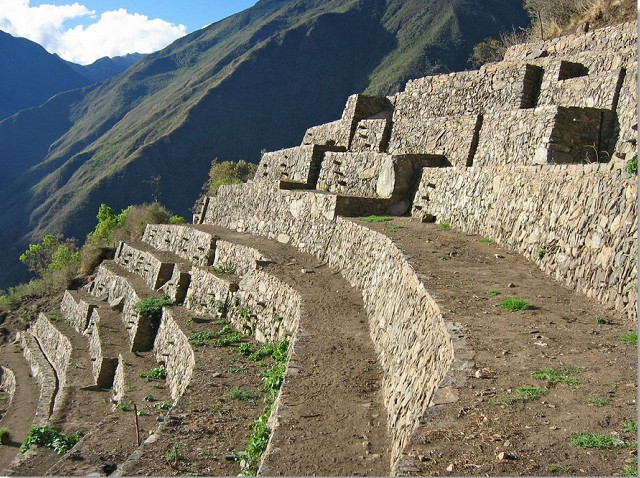
The previous year I had arrived for the first time
with a filming expedition, reopening the long,
multi-day trail across the rugged highlands from
Machu Picchu with picks, shovels and machetes.
Now twenty years later, I am returning yet again
to contemplate Choquequirao's mysteries and matchless
beauty, trekking in by the shorter, two-day route
from the road head near the community of Cachora.
University of Colorado archeoastronomer, Kim Malville
and I recently published my life's work in the
Andes and our studies together of Choquequirao,
in a new book entitled "Machu Picchu's Sacred
Sisters, Choquequirao and Llactapata." The book
focuses on similarities with Machu Picchu,
concluding that Choquequirao was modeled and
geocosmically located after its older ceremonial
sister.
We describe our collective findings and contributions
of colleagues in detail with a few adventures thrown
in from journals as well. The chapters cover main
and outlying groups, architectural features,
construction techniques, probable usage, function,
and how the Inca design incorporates Andean
astronomy and the sacred landscape. In brief,
we suggest that Choquequirao was designed and
constructed during the reign of the Inca, Topa
Yupanki, sometime in the late fifteenth century,
modeled after his father, Pachachuti's estate,
Machu Picchu.
Topa Inca had Choquequirao built as his own Machu Picchu.
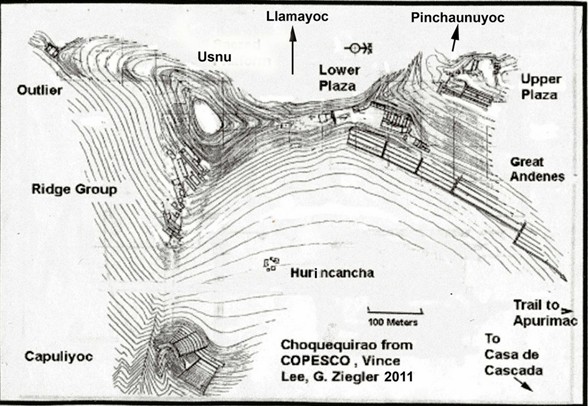
Experience from field investigations indicates Inca
monumental sites were carefully planned and designed
according to astronomical alignments, precisely
placed in relationship to sacred rivers, mountains,
and celestial phenomena.
Choquequirao fits this view. It was uniquely
located at a convergence of sacred terrain
features with celestial events most important to
the Inca state religion and Andean tradition
in particular, the June and December solstices.
Like Machu Picchu, important, high-status construction
is centered on a ridge top with a higher mountain
behind and a lower distinctive promontory in front,
with a sacred river flowing below in view. Each
hosts a series of fountains or baths passing through
ridge top groups.
During the height of the Inca empire, 1450-1526,
both Choquequirao and Machu Picchu would likely
have served as a provincial administrative center.
There is reasonable evidence that Machu Picchu
and Choquequirao may have also provided a
seasonal pilgrimage destination for
regional state-sponsored ceremonial events.
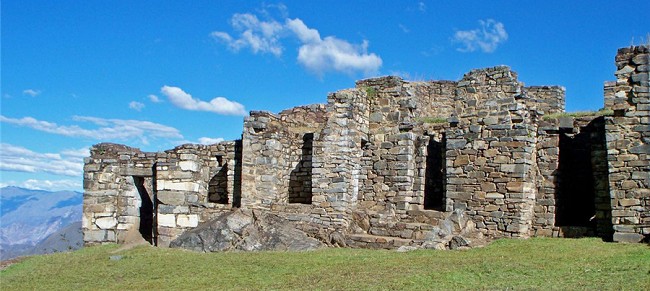
It is easy to envision a great procession of corn
beer, chicha drinking pilgrims singing and chanting,
conch shells blowing, melodic flutes forlornly
playing, drums reverberating from the canyon walls
as the outer gate is approached. Pots and cups are
ritually broken and offerings, borne in for the
mountain spirits, apus, are piled about as the
ceremony starts, carefully choreographed by richly
dressed attendant priests.
Evidence that coca was widely grown, coca store
houses, llama pens and a unique llama train mural,
support Choquequirao as an important coca growing
and distribution center. Intensive cultivation,
ongoing construction and maintenance would have
required a large resident population. Remains of
a large settlement of simple, round, wood
dwellings contained by low stone walls is situated
over an area of several square miles, above an
outlying temple water shrine, Pinchaunuyoc. These
would have housed the needed workers well away
from privileged resident Inca administrators,
attendants, and main group temples.
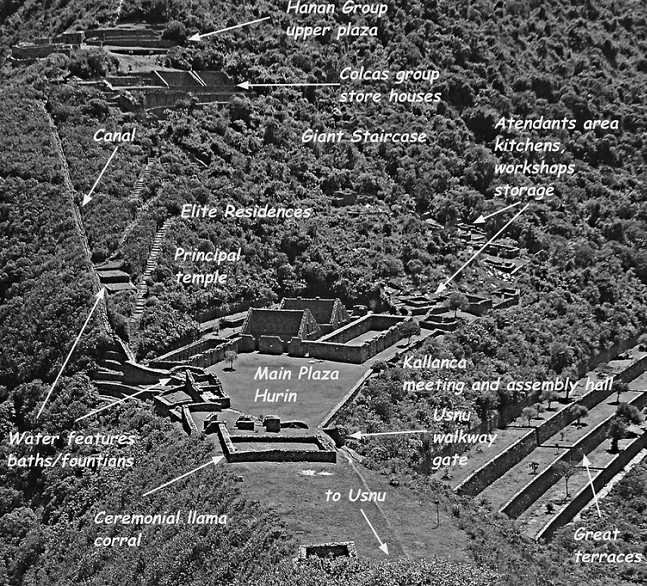
Visiting Choquequirao
Upon arrival at Choquequirao, one should allow several
days to explore the site and visit the two most
important outlying groups. Pinchaunuyoc, several
miles away, requires several thousand feet of climbing
down and back up for a round trip. The waterfall group,
Casa de Cascada, uses up the better part of a day
to visit and return.
Both are well worth the time.
One of the rewards of visiting Choquequirao is that
it has remained well off the beaten path. Only a few
hundred visit during the dry season as compared to
more than two thousand daily at Machu Picchu.
Arriving by the shortest route requires two days
of strenuous hiking.
Descending into the deep Apurimac then back up some
4,500 feet to reach the site is like crossing
Arizona's Grand Canyon.
One either carries a heavy backpack or hires
local packers to bring the needed supplies with
horses or mules. The best solution is to sign on
with one of the Cusco-based trekking agencies
that regularly take small groups of two to six
there during the dry season months of April into
December.
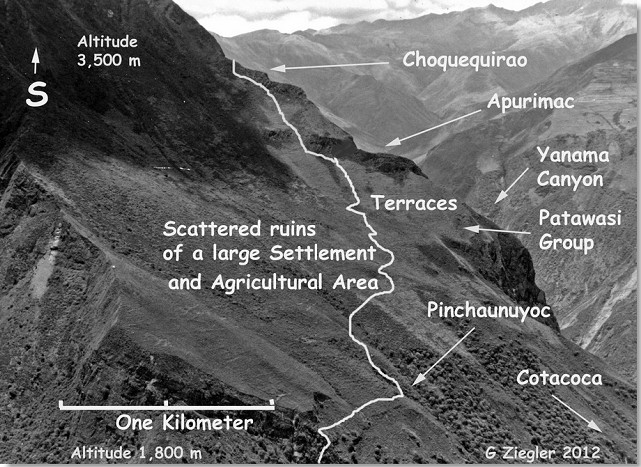
It is possible to ride a horse most of the way
but good horses are hard to come by. Most of
the local packer stock is not up to standards
of safety and dependability nor well cared for.
Some trekking agencies are marginal. A good test
is the cost. If it seems really cheap, there is
a reason. Carefully research and checking
references before signing on is recommended.
An old Cusco friend and Inca expert, Edwin Duenas,
operates trips by horseback and foot with
customized itineraries to Choquequirao and
other sites for individuals and small groups
out of Cusco. Edwin has worked with me as a field
research associate for many years. We have led
groups together on a number of occasions. I highly
recommend contracting him as the best archaeological
guide and outfitter available.
www.adventurespecialists.org
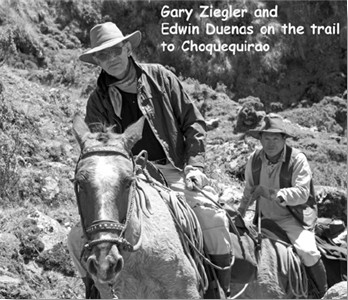
The small community of Cachora sits in a lush,
broad valley leading down to an immensely steep
drop to the Apurimac River. Agriculture and
travel in the valley goes back to pre-Inca times.
To CachoraThe present colonial-period community
was established as a part of Hernando Pizarro's
holdings or encomienda in the the mid-1500s. Life
here was pretty much unchanged until the Maoist
terrorist group, Sendero Luminoso, took violent
control in the 1980s.
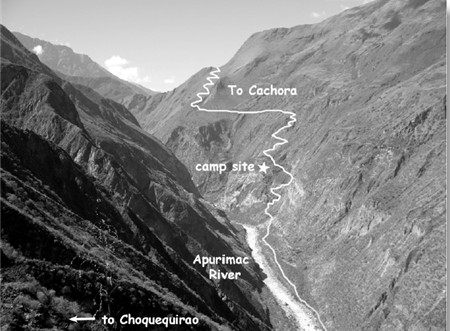
Many villagers with training or education were
rounded up and executed as a preliminary to
establishing absolute control.
I heard these horror stories when visiting there
just after government troops and national police
evicted the Senderistas following the capture
of Sendero leader Abimael Guzman in 1992. Work
at Choquequirao and growing tourism has put
the community back on track.
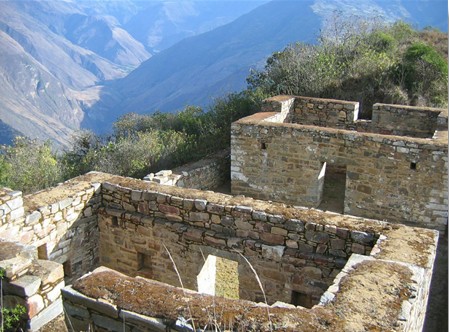
Traveling from Cusco, allow the better part of
a day to arrive at Cachora. As of this writing,
it takes five to six hours. The highway access
regularly slides away with slow, repair-created
detours and hosts increasingly heavy truck
traffic. Some of the route has returned to pot
holes and extreme dust. No solution has appeared
to solve these delays. Highways can't be built
to hold on steep, unstable, Andean mountain slopes.
Of course, the Inca knew this and carefully placed
their foot and pack llama-travelled roads up,
down and around where modern roads won't work.
The Cachora road turns off of the mostly-paved
Central highway just past the Inca monument,
Saihuite, to wind down several thousand feet to
the community. There are a few small, rustic places
to stay at with basic Andean food: chicken,
soups and beer.
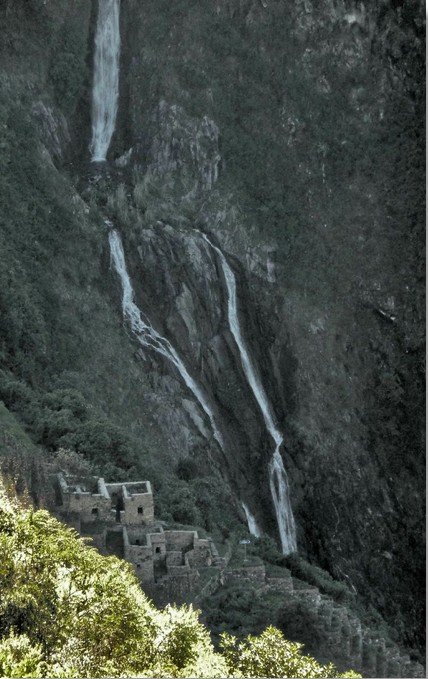
Although serious trekkers can reach the camp at
Choquequirao in one horrendous, long day, two
days is the reasonable norm. A minimum of six
days should be allowed for a visit and round
trip from Cachora. The usually well-maintained
trail follows along the rim of the Apurimac canyon,
with considerable up and downs before finally
dropping steeply to the river and bridge. There
are two suitable places to camp. The first is high
up before the drop to the river. Someone has built
a couple of shelters there, cold showers and piped
in water. There are ample, flat places for tents.
Usually someone is there to sell beer or Inca Kola.
The second camp is at the river. The government
agency, COPESCO, built a structure for housing
workers while building the bridge. As of this
writing it has been renovated and is serviceable.
There are plenty of tent sites and one can cool
off in the river. It is hot at an altitude of
around 5000 feet.
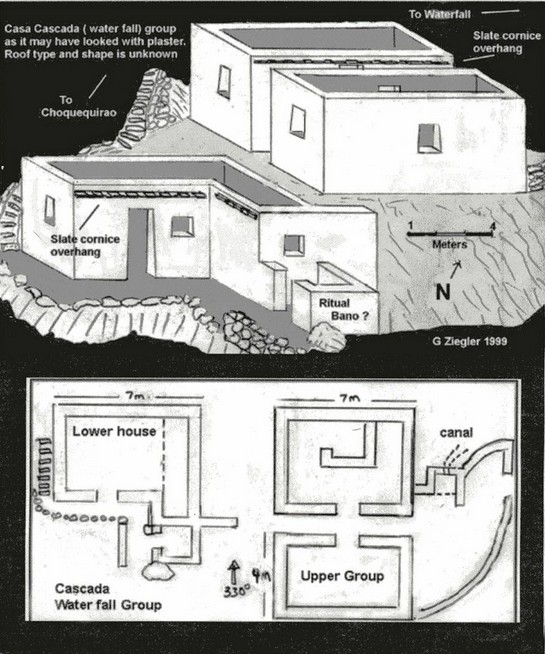
The vegetation looks like Sonoran Desert, cactus
and thorny acacia trees. Small biting gnats lurk
in ambush so bring repellant, long sleeves and a
closable tent. The trail switch-backs steeply up
after the bridge, climbing steadily until arriving
at Choquequirao.
Several small farms, chacras, are passed along the
way and higher up are small clusters of houses,
fields and corrals. A campsite with water and a
latrine has been built about an hour or so from
the archaeological complex, where one can camp
for a small fee.
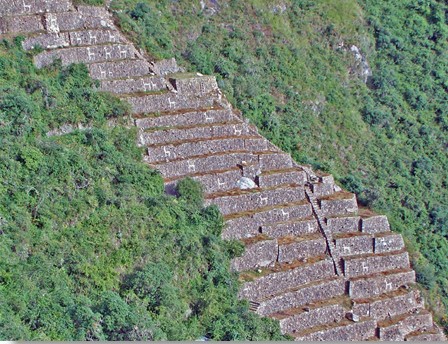
Just before reaching the edge of the designated
zone, the government INC, now renamed the Ministry
of Culture, (MC), has placed a small toll booth
where a fee is collected. As of our last visit,
it was forty Soles which is probably justified by
the new camping site with flush toilets and a cold
water shower house. From the camp, it is easy to
follow the pathways around the main groups which
are marked by signs.
Carry Machu Picchu's Sacred Sisters with you to
help identify the groups, structures and alignments
of the various buildings, walls and features. Visiting
the distant groups of Capullyoc, Hurincancha or the
Casa de Cascada may require a guide. Allow most of
a day for any of these. Llamayoc, the llama mural
in stone, can be seen in an hour or two as it is
close down from the Lower Plaza.
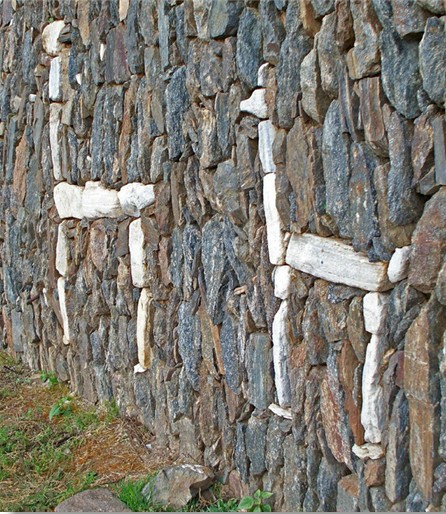
A walking tour of Topa Inca's estate: suggestions
that may be helpful.
1) From the developed camping area follow a
small path leaving from the shower house uphill
to the main trail above. Turn left on the trail,
following it southward. Within a few minutes,
you are on the large, walled terraces. The trail
continues until you reach the far end. It then
turns right and upward a short distance to enter
the main (Hurin) plaza. The plaza can be the
central staging point for visiting all of the
main groups.
2) Using the annotated photo diagram in the
book, visit and examine the building groups
and water features that surround the plaza.
3) Next, find a trail leaving from the northwest
corner of the plaza climbing upward or north to
the upper plaza group. There should be a sign
in place. In any case, carry a compass to aid
navigation and to observe alignments of the
features as we described in the book.
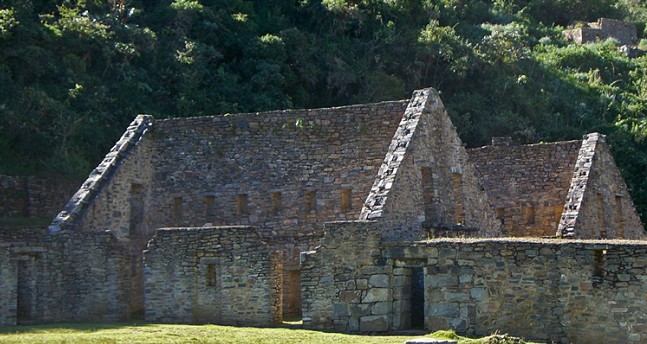
4) Climb upward following the trail near the
restored water canal several hundred feet to
reach the upper, Hanan plaza and the collection
of interesting buildings, fountain structures
and temples that face a spectacular view of
the deep Apurimac Canyon below.
5) Returning to the main plaza below, follow a
different trail bearing off to the left or
east side of the upper plaza, down through a
group of large buildings that we identify as
store houses, colcas. Find the December
solstice-aligned, Giant Staircase just below
the colcas. The trail continues down, passing
by a group of crude structures that we believe
were attendant and kitchen quarters, to again
enter the main plaza.
6) From the main plaza, pass through the big
double-jamb doorway on the left or east end
of the curious multi-angle, Hurin temple forming
the southern end of the plaza. Passing several
low-walled structures, which probably were holding
pens for llama related rituals, the path climbs
several hundred feet up to reach the big flat
topped hill we call the Usnu. Spend time here
to admire the overwhelmingly powerful view of
the surrounding Andes as did the Inca residents.
This is a great place for photos when the
never-certain Andean weather permits.
7) Continue over the Usnu hill southward
following a path down the descending ridge
crest. After passing several small platforms
and walls, the trail ends at what Bingham named
the "Outlier Group" now called the Casa de
Sacerdotes (House of the Priests).
The view down the big canyon and surrounding
ice peaks is, of course, awesome.
8) Returning back up the ridge, take a small
trail branching off to the right or east just
a bit above the Casa de Sacerdotes. This route
leads through dense, cloud forest tangle around
to an east-facing ridge running down from the Usnu
hill which hosts the Ridge Group (Pika Wasi). From
the uppermost group structures, find a good trail
leading uphill back to the main plaza.
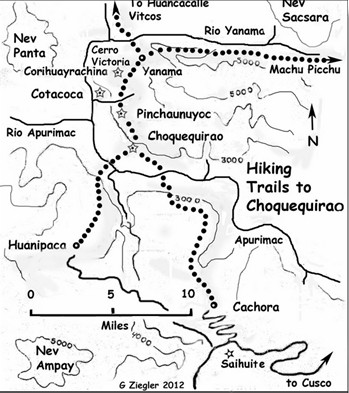
9) From the plaza, a sign marks an entranceway
at the water feature group that is the start of
a steeply descending trail to the Llama mural
terraces (Llamayoc) some distance below (west).
Trails mapAllow ample time for this visit. It is
a demanding climb back to the plaza.
This itinerary will require the better part of a
day. A full additional day should be set aside to
visit Pinchaunuyoc or the Casa de Cascada. The
Hurincanca group has been reclaimed by dense
vegetation so is sadly again lost. Finding and
studying the site will require a good day and a
crew with machetes. We do have the GPS location.
Our 1999 diagram is in the book available for
a future visit and study.
The Casa de Cascada is located some 1500 feet
down-slope below the camping site. The trail is
good but the start is not well indicated. If
possible, ask one of the visiting group tour
guides who may know, or one of the site workers
if you speak a bit of Spanish. A trip to the
hanging terraces, Capuliyoc, further along the
same trail should be included on the same day.
The other satellite group associated directly
with Choquequirao, Pinchaunuyoc is well worth
a visit but is a few miles distant, involving a
drop of several thousand feet on a very steep
switchbacking trail. It is a favorite overnight
stop on the long route to and from Machu Picchu.
It should be done as an overnight trip from
Choquequirao. Again, best to ask directions
as suggested above.
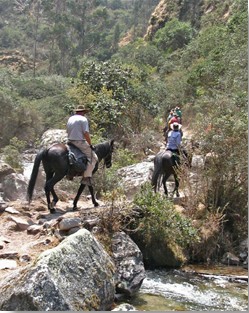
Heading for Cusco - on the road again.
A reality of trail travel in the steep Andes is
that slides and floods frequently remove sections
of trails. During May of 2011, a tremendous rock
slide briefly blocked the Apurimac which backed
up to destroy the bridge on the Choquequirao route
from Cachora. It was just reopened in August
of 2014.
Anyway, the flora study completed, we are
homeward bound. The day breaks bright and clear,
despejado as we say in the equatorial Andes.
After a brilliant Andean sunrise, our sunrise
photographers return and camp is packed. All mount
the rested, energized horses to trot cheerfully
along good, near-level, trail traversing high above
the roaring Apurimac River below. Later today, we
must descend to the river and cross on
a swaying cable-suspended box. Some seem to
greet this expectation with limited enthusiasm.
Today's journey is comparable to a crossing of
the Grand Canyon but by now all are fit, and
comfortable with long descents and slow, steady
climbs. We ride what we can but like me, some
walked much of the way, particularly on steep
difficult trail. Anyway, it is good to have a
trusty, calm mount to hop on to when the need
moves you. More, we carry no burdensome day packs
or gear, which is stashed in the saddle bags
traveling nearby when needed.
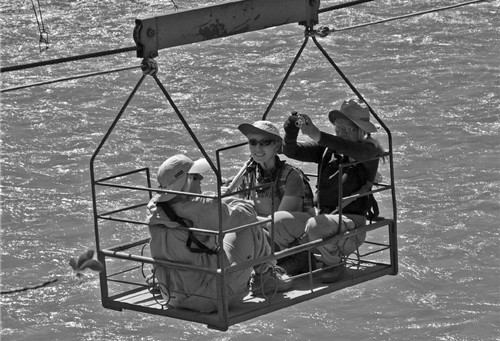
I travel light, wearing running shoes with legs
protected for riding by leather gaiters called
in the riding trade, half chaps. These serve well
for hiking through brush and snake country as well.
Several hours' travel downhill places us at the
trail's end, bridge abutments with forlornly
sagging cables and alas, no flooring. The bridge
is gone. An immense rock slide had dammed up the
Apurimac just downriver, creating a dam that backed
up water to the bridge, destroying planking and
lower supports.
Choquequirao was effectively closed except for
hardy travelers coming and going by the long
arduous route in and out via Yanama or by the
swinging cable car. This reflects a millennium
of hard life in the Andes. It has never been easy
and the natural environment is cruel to the
careless or unfortunate. Civilizations have
come and gone here, even for the privileged.
We are happy to just cross the river on whatever
means available. That means is an oroya, a long
cable and a small box like contraption attached
on pulleys with a pull rope to haul one across
above the raging rapids. Our trusted horses and
pack stock are necessarily left behind. New mounts,
sturdy mules and saddle horses await us on the far
bank if we successfully survive the cable crossing,
which I can happily report we do.
We face bonding with a new wrangler crew and
unknown new equines but, this is the stuff of
adventure. All rise admirably to the occasion.
We are soon sharing tales in a comfortable camp
some distance up from the buggy river bottom on
an ancient, pre-Inca, breezy plateau with running
water and bottled beer, recently developed as a
tourist encampment. They even have a flush toilet
marginally in operation although several of us opt
for the nearby woods. In any case, the local
mosquitoes relish the opportunity for exposed bottoms.
Enough time in the wilds - "the bright lights of
Cusco are shining like
diamonds, like ten thousand
jewels in the sky."
The next morning, we mount up or strike out
walking. It is a mere four thousand feet uphill
and ten miles to our awaiting transport near
the village of Cachora. We get it done without
mishap. Evening finds us enjoying a late meal
in Cusco's favorite pub, noted British ornithologist
Barry Walker's Cross Keys. It was a great,
successful adventure…
Maybe I will have that second Pisco?
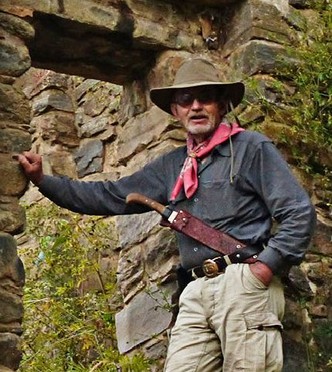
Gary Ziegler is a field archaeologist with a
geology background, a mountaineer and explorer
who has spent a lifetime finding and studying
remote sites in the Vilcabamba range of Peru's
southern Andes. He is a Fellow of the Royal
Geographical Society and of the Explorers Club.
He has featured in documentary films for the
BBC, Discovery Channel, Science and History
Channels. His work has been published in
numerous professional journals, and he is
co-author of "Machu Picchu's Sacred Sisters:
Choquequirao and Llactapata." He has taught
at Colorado College and Peru's national
university, San Marcos. He was awarded the
title "Distinguished Lecturer" at NASA's
Marshal Space Center in 2013. His home base
is the 4000-acre Bear Basin Ranch in the Sangre
de Cristo mountains of southern Colorado.
He can be contacted at:
info@adventurespecialists.org
and www.adventurespecialists.org
Photo credits: Thanks to Steve Bein,
Ken Greenwood,
Paolo Greer, Lillian Roberts
and Hugh Thomson.
FEEDBACK MAP
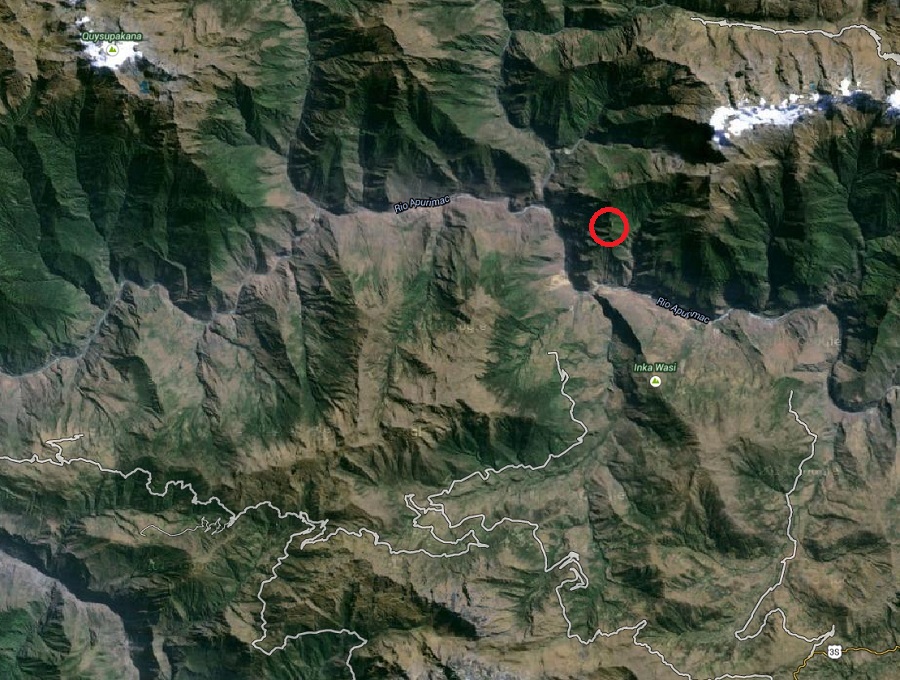
If you got impressions for
which this feedback is
insufficient, more information,
pictures and videos can
be found at the following web sites:
Facebook
Wikipedia
Trekking to Choquequirao, Peru’s remote Inca ruins
Many thanks to Ray McClure for creating this target.




















